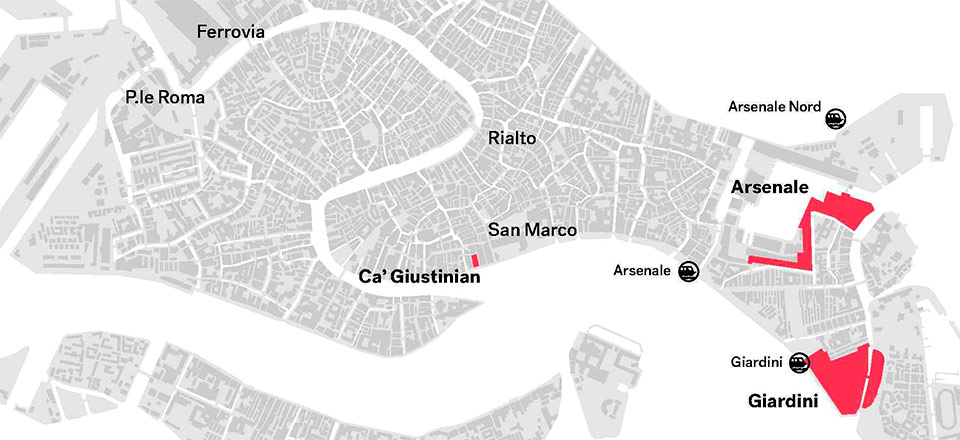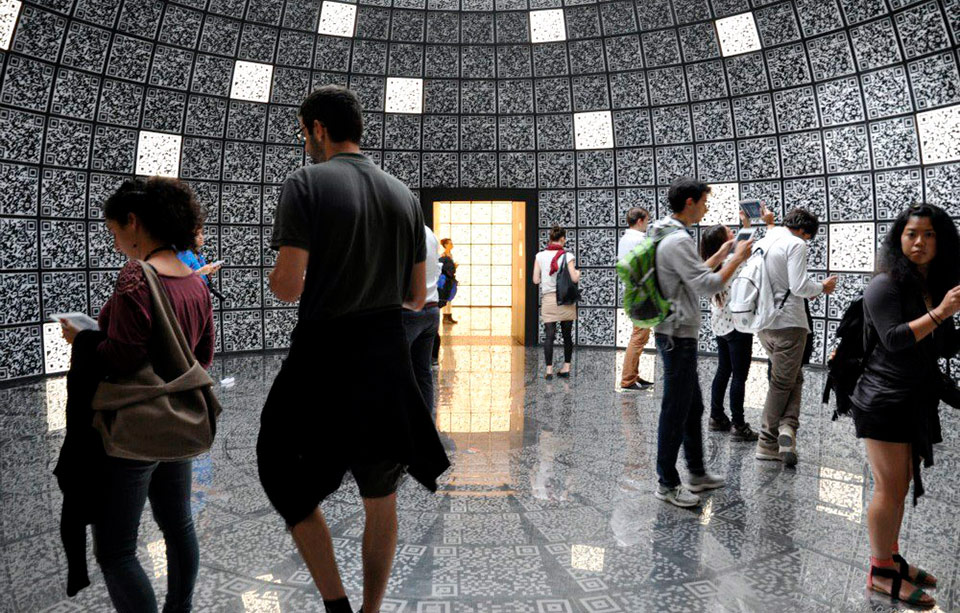The Venice Art Biennale is a major contemporary art exhibition that takes place once every two years in Venice. The Venice Film Festival is part of it, as is the Venice Biennale of Architecture.
The Venice Biennale is celebrating its 120 years. When it was inaugurated in 1895 in the Giardini, there were no national pavilions, only the Central Pavilion existed. The national pavilions followed twelve years later with the Belgian Pavilion in 1907, Hungary in 1909, France and Sweden in 1912 and Russia in 1914. Today there are 95 permanent pavilions at the Giardini and many other venues in Arsenale area and in the city.
The formal Biennale is based at a park the Giardini that houses 30 permanent national pavilions. There is no single format to how each country manages their pavilion. The pavilion for Great Britain is always managed by the British Council while the United States assigns the responsibility to a public gallery chosen by the Department of State. The Giardini includes a large exhibition hall that houses a themed exhibition curated by the Biennale's director.
The Aperto began as a fringe event for younger artists and artists of a national origin not represented by the permanent national pavilions. This is usually staged in the Arsenale and has become part of the formal biennale programme.
Venice Art Biennale Venues
Venues: Giardini, Arsenale and Forte Marghera.

Giardini Services: Bar, restaurant, bookshop, infopoint, restroom with changing table, courtesy transport service with electric cars for visitors with reduced mobility. Subject to availability: stroller, walker, wheelchair. Cloakroom service for small items. Small to medium size pets on a leash are admitted to the green area only.
Arsenale Services: Bar, restaurant, bookshop, infopoint, restroom with changing table, courtesy transport service with electric cars for visitors with reduced mobility. Subject to availability: stroller, walker, wheelchair. Cloakroom service for small items (unguarded). No animals admitted.
Venice Art Biennale Opening hours
- Opening hours: 10 am - 6 pm
- Closed on Mondays (Monday extraordinary openings will be announced)
Venice Art Biennale Tickets
- 3-day ticket.
- Single ticket.
- Student ticket.
- Guided tours.
The ticket is valid for one entry to the two exhibition venues (Giardini + Arsenale).
The National Pavilions and their Architects
Venice Art Biennale National Pavilions:
- Italy - Palazzo Pro Arte: Enrico Trevisanato, façade by Marius De Maria and Bartholomeo Bezzi, 1895; new façade by Guido Cirilli, 1914; Padiglione Italia, present façade by Duilio Torres 1932. The pavilion has a sculpture garden by Carlo Scarpa, 1952 and the Auditorium Pastor by Valeriano Pastor, 1977.
- Australia - Philip Cox, 1988
- Austria - Joseph Hoffmann, collaboration of Robert Kramreiter, 1934 (restored by Hans Hollein, 1984).
- Belgium - Leon Sneyers, 1907 (totally restored by Virgilio Vallot, 1948).
- Brazil - Amerigo Marchesin, 1964.
- Canada - BBPR (Gian Luigi Banfi, Barbiano di Belgiojoso, Enrico Peressutti, Ernesto Nathan Rogers), 1958.
- Czechoslovakia - Otakar Novotn, 1926 (annex built by Boguslav Rychlinch, 1970).
- Denmark - Carl Brummer, 1932 (annex designed by Peter Koch, 1958).
- Finland - Alvar Aalto, 1956; restored by Fredrik Fogh with the collaboration of Elsa Makiniemi, 1976-1982.
- France - Faust Finzi, 1912.
- Germany - Daniele Donghi, 1909; rebuilt by Ernst Haiger, 1938.
- Japan - Takamasa Yoshizaka, 1956
- Great Britain - Edwin Alfred Rickards, 1909.
- Greece - Brenno Del Giudice, M. Papandre, 1934.
- Iceland - At present it uses the Finnish pavilion.
- Israel - Zeev Rechter, 1952 (modified by Fredrik Fogh, 1966).
- Netherlands - Gustav Ferdninand Boberg, 1914 (rebuilt by Gerrit Thomas Rietveld, 1954).
- Russia - Aleksej V. Scusev, 1914.
- Scandinavia (Norway, Sweden, Finland) - Sverre Fehn, 1962 (small annex built by Fredrik Fogh, 1987).
- Spain - Javier de Luque, 1922 (façade restored by Joaquin Vaquero Palacios, 1952).
- USA - Chester Holmes Aldrich, William Adams Delano, 1930.
- Switzerland - Bruno Giacometti, 1952.
- Hungary - Geza Rintel Maroti, 1909 (restored by Agost Benkhard, 1958).
- Uruguay - Ex-warehouse of the Biennale, 1958, ceded to the government of Uruguay, 1960.
- Venezuela - Carlo Scarpa, 1956.
- Venezia Group of Pavilions - Brenno Del Giudice (Arti Decorative pavilion 1932); other pavilions (Yugoslavia, Romania, Latin America), 1938; Egypt was assigned a pavilion in 1952.
- South Korea - Seok Chul Kim, 1995.
- Ticket Office - Carlo Scarpa, 1951.
- Book Shop - James Stirling, 1991.
History of Venice Art Biennale
The first Venice Art Biennale was held in 1895; during the first editions, decorative arts played an important role. The event became more and more international in the first decades of the 20th century: from 1907 on, several countries started installing national pavilions at the exhibition. After World War I, the Biennale showed increasing interest in innovative traditions in modern art. Between the two World Wars, many important modern artists had their work exhibited there.
In 1930, control of the Biennale passed from the Venice city council to the national Fascist government. In the 1930s, several new sections of the event were established: the Music Festival in 1930, the International Film Festival in 1932 and the Theatre Festival in 1934. From 1938, Grand Prizes were awarded in the art exhibition section.
After a six-year break during World War II, the Biennale was resumed in 1948 with renewed attention to avant-garde movements in European, and later worldwide, movements in contemporary art. Abstract expressionism was introduced in the 1950s, pop art in the 1960s. From 1948 to 1972, Italian architect Carlo Scarpa did a series of remarkable interventions in the Biennales exhibition spaces.
The protests of 1968 marked a crisis for the Biennale; the Grand Prizes were abandoned and more emphasis went to thematic exhibitions instead of monographic ones. The 1974 edition was entirely dedicated to Chile, as a major cultural protest against the dictatorship of Augusto Pinochet. New prizes - Golden Lions, like the awards for the Venice Film Festival - were installed; postmodern art entered the scene with increasingly varied and popular exhibitions.
In 1980 Achille Bonito Oliva and Harald Szeemann introduced "Aperto", a section of the exhibition designed to explore emerging art. Italian art historian Giovanni Carandente directed the 1988 and 1990 editions. A three-year gap was left afterwards to make sure that the 1995 edition would coincide with the 100th anniversary of the Biennale. The 1993 edition was directed by Achille Bonito Oliva while Jean Clair and Germano Celant served as directors in 1995 and 1997 respectively.
In 1999 and 2001, Harald Szeemann directed two editions in a row (48th & 49th) bringing in a larger representation of artists from Asia and Eastern Europe and more young artist than usual and expanded the show into several newly restored spaces of the Arsenale.
The 50th edition, directed by Francesco Bonami, had a record number of seven co-curators involved, including Hans Ulrich Obrist, Catherine David, Igor Zabel, Hou Hanru and Massimiliano Gioni.
The 51st edition of the Biennale opened in June 2005, curated, for the first time by two women, Maria de Corral and Rosa Martinez. De Corral organized "The Experience of Art" which included 41 artists, from past masters to younger figures. Rosa Martinez took over the Arsenale with "Always a Little Further." Drawing on "the myth of the romantic traveler" her exhibition involved 49 artists, ranging from the elegant to the profane.
At the 51st Biennale, American artist Barbara Kruger was awarded with the "Golden Lion" award for lifetime achievement.
In 2007, Robert Storr became the first director from the United States to curate the 52nd edition of the Biennale entitled Think with the Senses – Feel with the Mind. Art in the Present Tense. This year, Mexico made its official debut at the Biennale with an exhibition by artist Rafael Lozano-Hemmer at the Van Axel palace.
A dance section, the International Festival of Contemporary Dance, was established in 1999.




